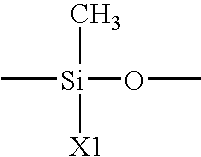Compositions with cyclopropenes and non-hydrocarbon oils
- Summary
- Abstract
- Description
- Claims
- Application Information
AI Technical Summary
Benefits of technology
Problems solved by technology
Method used
Image
Examples
example 1
Tomato Epinasty Testing Using 1-MCP and Silicone Oils:
[0061] Tomato epinasty tests were performed as follows:
[0062] Tomatoes (Rutgers 39 Variety Harris Seeds No 885 Lot 37729-A3) were grown in 6.35 cm (2.5 inch) square pots filled with a commercial potting mix. Two seeds were place in each pot. Plants that had expanded first true leaves and were between 7.5 and 12.7 cm (3 and 5 inches) high were used for the tomato epinasty test.
[0063] To conduct the assay, the plants were sprayed to run off with the test 1-MCP foliar spray and allowed to dry for 4 hours in sunlight. These operations were performed in a ventilated area away from the plants growing in the greenhouse so there would not be any unintended treatment to growing plants destined for later experiments.
[0064] The 1-MCP treated plants and both treated and untreated controls were placed into an SLX controlled-atmosphere shipping box and sealed. To the box, ethylene was injected through a septum, which gave a concentration ...
example 2
Tomato Epinasty Testing Using 1-MCP and Silicone Oils with Surfactant
[0073] Tomato epinasty tests were conducted as in Example One using a formulation that included water; a 1-MCP α-CD complex that contained 0.14% 1-MCP by weight, based on the weight of the 1 -MCP α-CD complex; and sodium salt of EDTA. The amount of 1-MCP α-CD complex was chosen so that the spray formulation had 15 1.2 ppm of 1-MCP. The amount of sodium salt of EDTA was kept at 50 ppm. Also included in the spray formulations were various silicone oils at 0. 1% by weight based on the weight of the spray formulation and sodium dioctylsufosuccinate surfactant at 0.05 % by weight based on the weight of the spray formulation. Results were as follows:
Oil / Surfactant1-MCPConcentrationConcentra-in Spray%tionSolutionControl ofSilicone oil Adjuvant(ppm)(Weight %)EpinastyNone (control)1.208Poly (dimethyl siloxane-co-1.20.1 / 0.0583methyl hydrosiloxane)1,1,1,3,5,5,5 heptamethyl1.20.1 / 0.0553trisiloxanePoly (dimethyl siloxane-c0...
example 3
Tomato Epinasty Testing Using 1-MCP and Soybean Oil
[0074] Tomato epinasty tests were conducted as in Example One except that the plants were sprayed in a spray hood (DeVries Mfg., Hollandale, MN) equipped with a motorized track sprayer designed to deliver calibrated amounts of spray to the plants. 10 The formulation included water; a 1-MCP α-CD complex that contained 2% 1-MCP by weight, based on the weight of the 1-MCP α-CD complex; and sodium salt of EDTA. The amount of 1-MCP α-CD complex was chosen so that a reasonable amount of epinasty control was achieved. The amount of sodium salt of EDTA was kept at 50 ppm. Also included in the spray formulation was soybean oil containing 15 40% of Atplus™ 367 surfactant. (Uniqema Corp.) at 3% by weight based on the weight of the spray formulation. Results were as follows:
Adjuvant1-MCP SprayConcentration inRateSpray Solution% Control ofSpray Adjuvant(grams / hectare)(Weight %)EpinastyNone (control)2002660% Soybean oil / 40%5364Atplus 367 surf...
PUM
 Login to View More
Login to View More Abstract
Description
Claims
Application Information
 Login to View More
Login to View More - R&D
- Intellectual Property
- Life Sciences
- Materials
- Tech Scout
- Unparalleled Data Quality
- Higher Quality Content
- 60% Fewer Hallucinations
Browse by: Latest US Patents, China's latest patents, Technical Efficacy Thesaurus, Application Domain, Technology Topic, Popular Technical Reports.
© 2025 PatSnap. All rights reserved.Legal|Privacy policy|Modern Slavery Act Transparency Statement|Sitemap|About US| Contact US: help@patsnap.com



